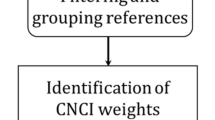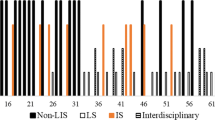Abstract
This stated preference study approached the issue on sub-categorization of the information science–library science (IS–LS) journals listed in the Journal Citation Report (JCR) 2011. To investigate this, 243 active authors/editors publishing in this field were requested to indicate their preferred category to 83 journal titles listed in JCR 2011 from four options: information science (IS), library science (LS), information systems (ISys) and do not know/undecided. Based on the popularity count, respondents assigned 39 titles to LS, 23 titles to IS and 21 titles to ISys. Twenty-five titles received high “do-not-know” counts—these are titles in non-English languages, information management and publishing sub-fields. Only one title in LS was grouped in the highest quartile by impact factor, compared to 8 titles in IS and 11 in ISys. This indicates that LS journals are hardly represented among the top 25 % of the impact factor distribution of JCR’s ranked IS–LS journals. Respondents show concern about the “fit” of information systems journals in the IS–LS category.
Similar content being viewed by others
References
Abrizah, A., Zainab, A. N., Kiran, K., & Raj, R. G. (2013). LIS journals scientific impact and subject categorization: A comparison between Web of Science and Scopus. Scientometrics, 94, 721–740.
Archambault, E., & Gagné, E. V. (2004). The Use of bibliometrics in social sciences and humanities. Montreal: Social Sciences and Humanities Research Council of Canada (SSHRCC).
Astrom, F. (2002). Visualizing library and information science concept spaces through keyword and citation based maps and clusters. In H. Bruce, et al. (Eds.), The fourth International Conference on Conceptions of Library and Information Science, University of Washington, Seattle, WA, July 21–25 2002 (pp. 185–197). Greenwood Village: Libraries Unlimited.
Astrom, F. (2007). Changes in the LIS research front: Time sliced cocitation analyses of LIS journal articles, 1990–2004. Journal of the American Society for Information Science and Technology, 58(7), 947–957.
Best, R. D., & Kneip, J. (2010). Library schools program and the successful training of academic librarians to meet promotion and tenure requirements in the academy. College & Research Libraries, 71(2), 97–114.
Boyack, K. W., Klavans, R., & Borner, K. (2005). Mapping the backbone of science. Scientometrics, 64(3), 351–374.
Delgado-Lopez-Cozar, E., & Cabezas-Clarijo, A. (2013). Ranking journals: Could Google Scholar metrices be an alternative to journal citation report and Scimago journal rank? Learned Publishing, 26(2), 101–114.
Glanzel, W., & Schubert, A. (2003). A new classification scheme of science fields and subfields designed for scientometric evaluation purposes. Scientometrics, 56(3), 357–367.
Gravetter, F. J., & Forzano, L. A. B. (2008). Research methods for the behavioral sciences. Eastbourne, East Sussex: Gardners Books.
Harzing, A. W., & Van der Wal, R. (2008). Google scholar as a new source for citation analysis. Ethics, Science Environmental politics, 8, 61–73.
Holsapple, C. W., Johnson, L. E., Manakyan, H., & Tanner, J. (1995). An empirical assessment and categorization of journals relevant to DSS research. Decision Support Systems, 14(4), 359–367.
Janssens, F., Zhang, L., & Glanzel, W. (2009). Hybrid clustering validation and improvement of subject-classification schemes. Information Processing and Management, 45(6), 683–702.
Katz, J. S., & Hicks, D. (1995). The classification of interdisciplinary journals: A new approach. Brighton: Social Policy Research Unit, University of Sussex.
Krejcie, R. V., & Morgan, D. W. (1970). Determining sample size for research activities. Educational and Psychological Measurement, 30, 607–610.
Leydesdorff, L. (2007). Betweenness centrality as an indicator of interdisciplinarity of scientific journals. Journal of the American Society for Information Science and Technology, 58(9), 1303–1319.
Leydosdorff, L., & Rafols, I. (2009). A global map of science based on the ISI subject categories. Journal of the American Society for Information Science and Technology, 60(2), 348–362.
Milojevic, S., Sugimoto, C. R., Yan, E. J., & Ding, Y. (2011). The cognitive structure of library and information science: Analysis of article title words. Journal of the American Society for Information Science and Technology, 62(10), 1933–1953.
Moya-Anegon, F., Herrero-Solana, V., & Jimenez-Contreras, E. (2006). A connectionist and multivariate approach to science maps: The SOM, clustering and MDS applied to Library science research and information. Journal of Information Science, 32(1), 63–77.
Ni, C. & Ding, Y. (2010). Journal clustering through interlocking editorship information. In Paper presented at the Proceedings of the 73rd ASIS&T Annual Meeting on Navigating Streams in an Information Ecosystem, Vol. 47, Pittsburgh, USA.
Ni, C. & Sugimoto, C. R. (2011). Four facets study of scholarly communities: Artifacts, producers, concepts and gatekeepers. In A. Grove (Ed.), Annual Meeting of the American Society for Information Science and Technology (Vol. 48, pp. 9–12). Louisiana, USA: New Orleas.
Ni, C., Sugimoto, C. R., & Cronin, B. (2013). Visualizing and comparing four facets of scholarly communication: Producers, artifacts, concepts and gatekeepers. Scientometrics, 94(3), 1161–1173.
Nisonger, T. E. (2007). Journals in the core collection: Definition, identification and applications. The Serials Librarian: From the Printed Page to the Digital Age, 51(3/4), 51–73.
Nisonger, T. E., & Davis, C. H. (2005). The perception of library and information science journals by LIS education deans and ARL library directors: A replication of the Kohl–Davis study. College & Research Libraries, 66(4), 341–377.
Nixon, J. (2014). Core journals in library and information science: developing a methodology for ranking LIS journals. Libraries Faculty and Staff Scholarship and Research, Paper 61. http://docs.lib.purdue.edu/cgi/viewcontent.cgi?article=1075&context=lib_fsdocs
Price, D. J. (1965). Networks of scientific papers. Science, 149, 510–515.
Rogelberg, S. G., & Stanton, J. M. (2007). Introduction: Understanding and dealing with organizational survey non-response. Organizational Research Methods, 10, 195–209.
Serenko, A., & Bontis, N. (2010). What’s familiar is excellent: The impact of exposure effect on perceived journal quality. Journal of Informetrics, 5(2011), 219–233.
Serenko, A., Bontis, N., Booker, L., Sadeddin, K., & Hardie, T. (2010). A scientometric analysis of knowledge management and intellectual capital academic literature (1994–2008). Journal of Knowledge Management, 14(1), 3–23.
Tahai, A., & Meyer, M. J. (1999). A revealed preference study of management journals’ direct influence. Strategic Management Journal, 20(3), 279–296.
Tseng, Y. H., & Tsay, M. Y. (2013). Journal clustering of library and information science for subfield delineation using the bibliometric analysis toolkit: CATAR. Scientometrics, 95(2), 503–528.
Waltman, L., Yan, E., & Van Eck, N. (2011). A recursive field-normalized bibliometric performance indicator: An application to the field of library and information science. Scientometrics, 89(1), 301–314.
Web of Science. (2002). Journal self-citation in the Journal Citation Reports—Science edition 2002. http://wokinfo.com/essays/journal-self-citation-jcr/. Accessed May 28, 2014.
Web of Science, Fact Sheet. (2012). http://thomsonreuters.com/business-unit/science/pdf/Web_of_Science_factsheet.pdf. Accessed Feb 7, 2013.
Zhang, L., Glanzel, W., & Liang, L. M. (2009a). Tracing the role of individual journals in a cross-citation network based on different indicators. Scientometrics, 81(3), 821–838.
Zhang, L., Janssens, F., Liang, L. M. & Glanzel, W. (2009). Hybrid clustering analysis for mapping large scientific domains. In B. Larsen, J. Leta (Eds.), Proceedings of ISSI 2009 The 12th International Conference on Scientometrics and Informetrics, Rio de Janeiro (pp. 178–188).
Acknowledgments
This research was funded by the Ministry of Higher Education Malaysia (HIR-MOHE) UM.C/HIR/MOHE/FCSIT/H22001/00B00011.
Author information
Authors and Affiliations
Corresponding author
Rights and permissions
About this article
Cite this article
Abrizah, A., Noorhidawati, A. & Zainab, A.N. LIS journals categorization in the Journal Citation Report: a stated preference study. Scientometrics 102, 1083–1099 (2015). https://doi.org/10.1007/s11192-014-1492-3
Received:
Published:
Issue Date:
DOI: https://doi.org/10.1007/s11192-014-1492-3




